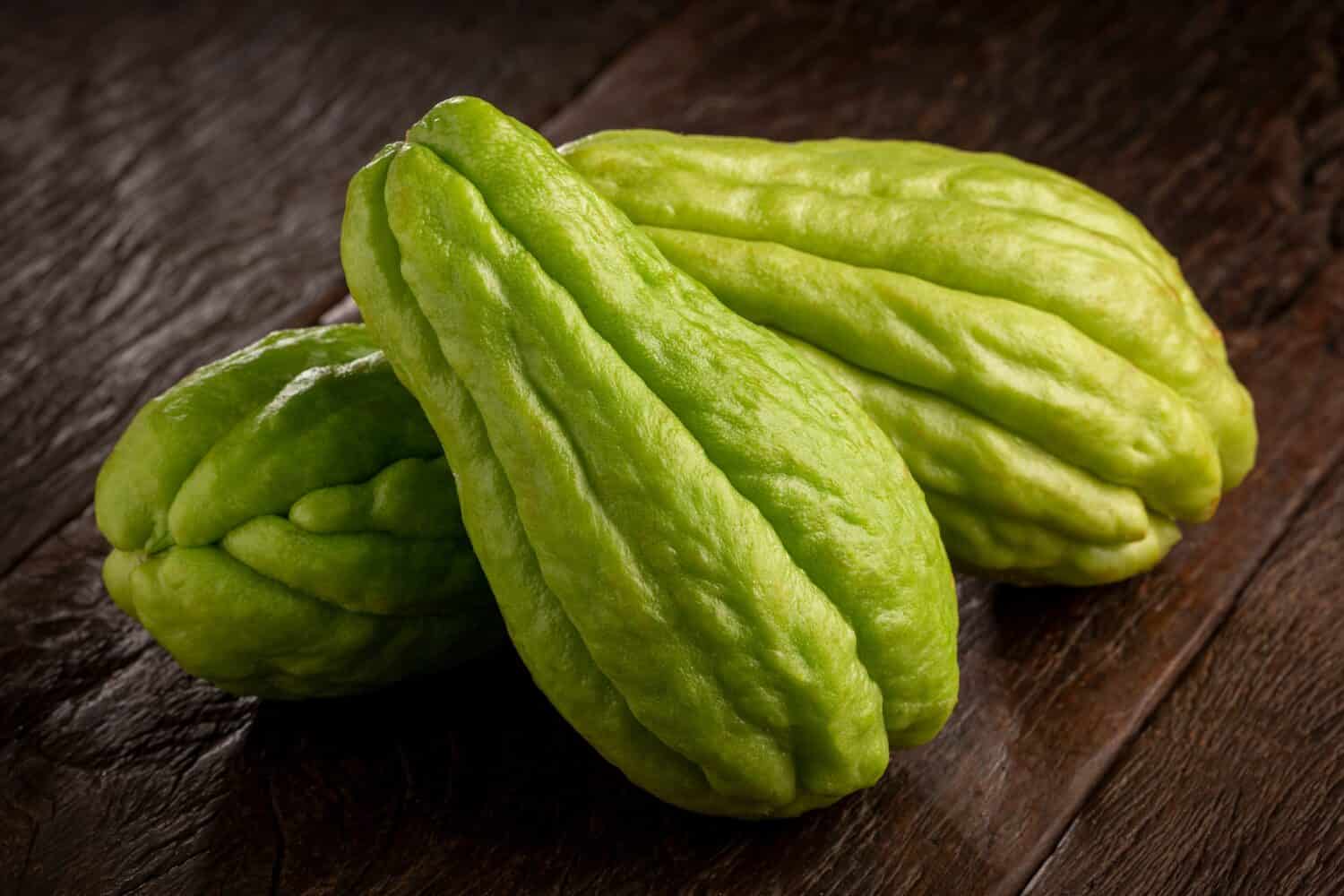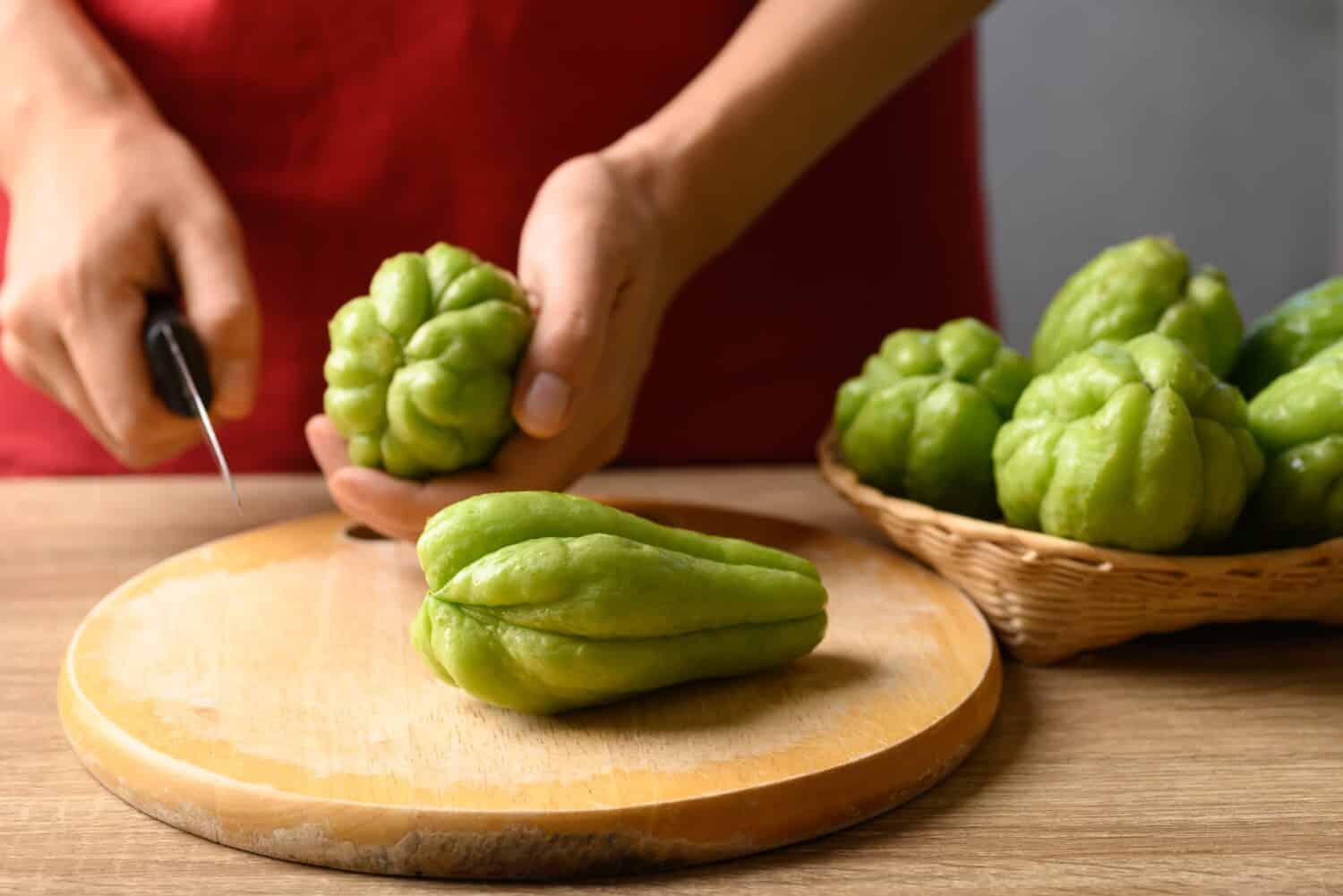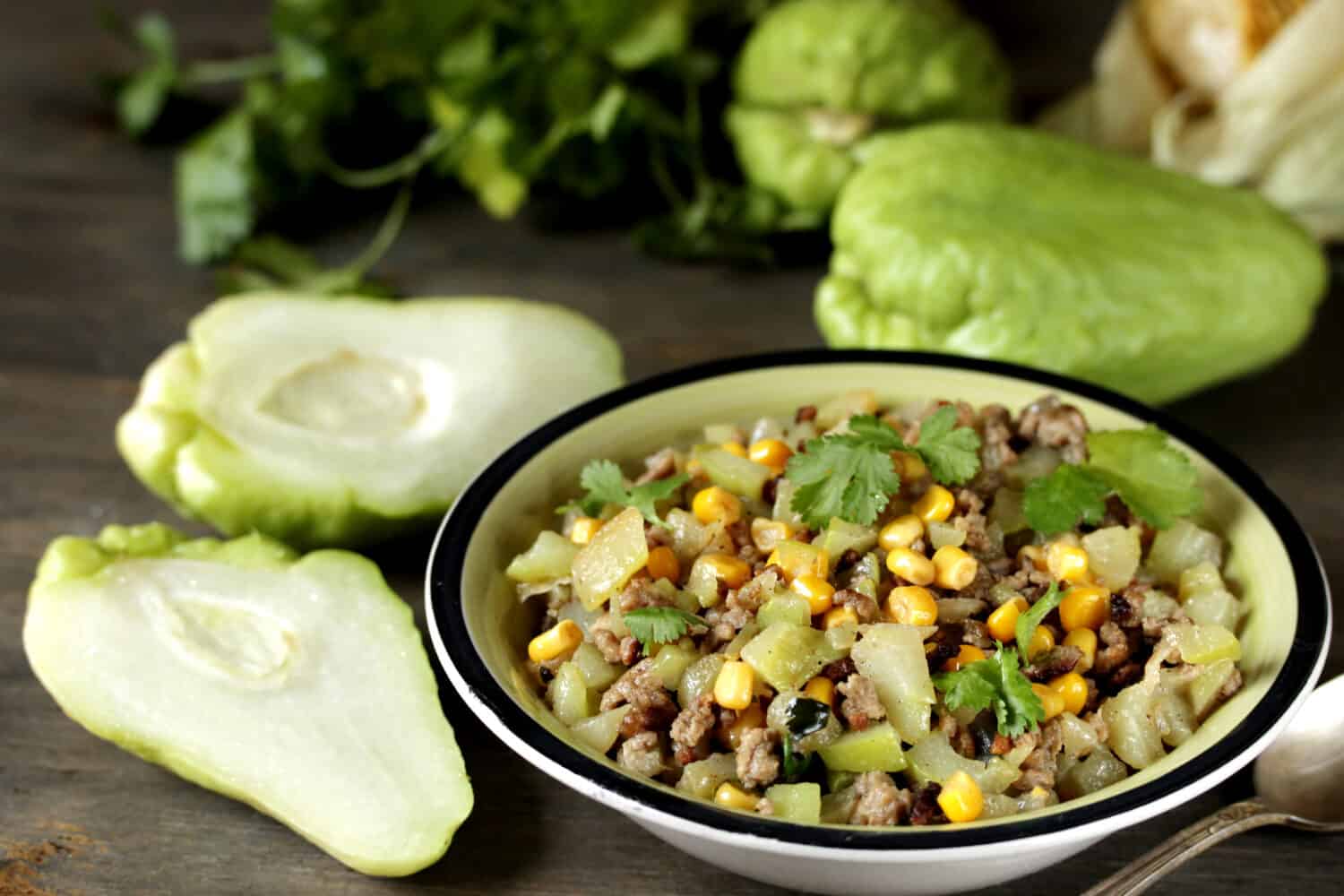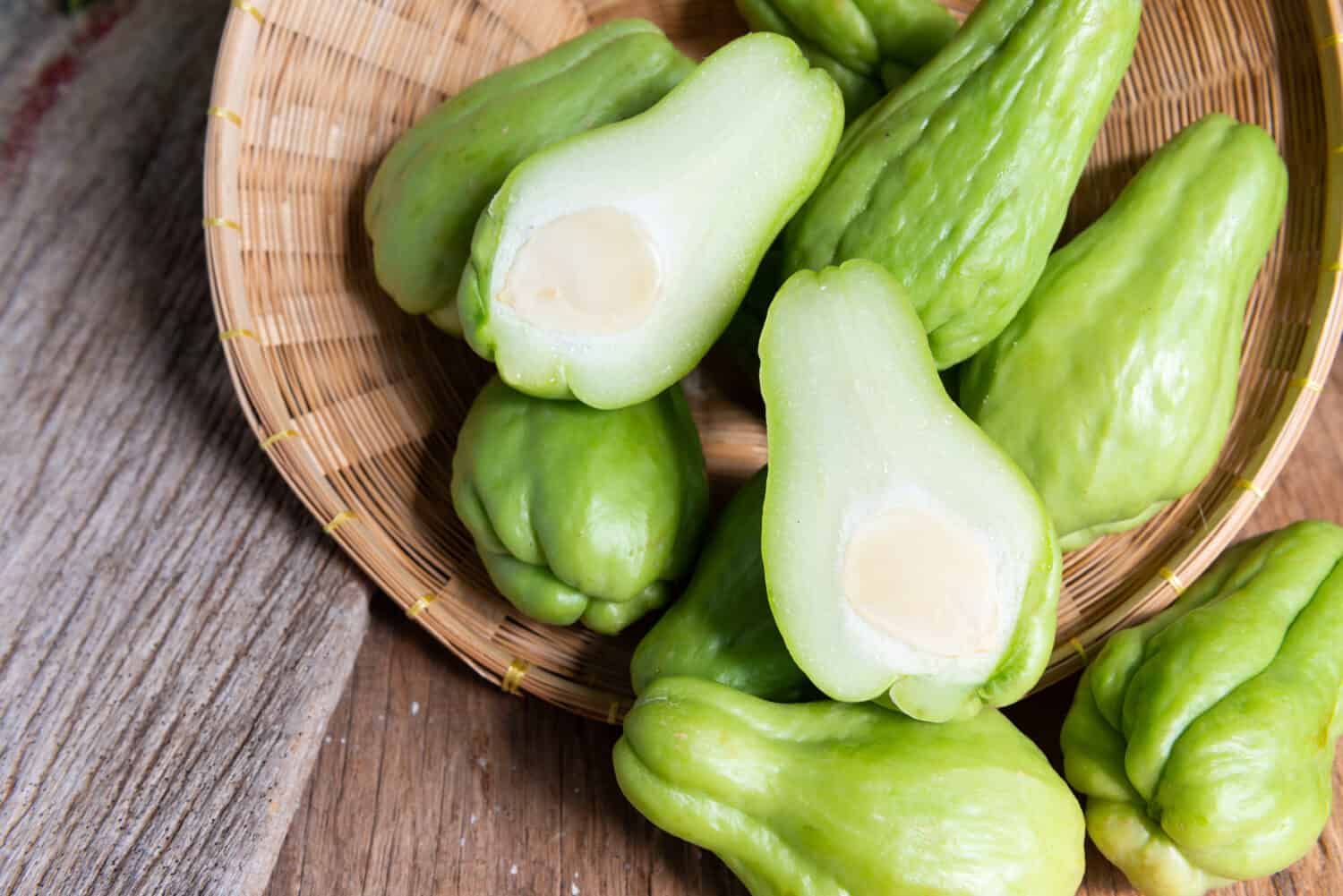With so many new health trends and ingredients gracing our shelves, it can be hard to keep up with all of the trends. Things like tempeh, kimchi, and kombucha are all over the media, and now there is another contender to add to your healthy mix. Enter the chayote. If you have never heard of a chayote, you are not alone; however, this is definitely a food that you are going to want to keep in your home. With its delicious flavor and full of nutritional benefits, this food will not disappoint. In this article, we will discuss all things chayote, from what a chayote squash is to how to cook it, its health benefits, and more!
What is Chayote?

©WS-Studio/Shutterstock.com
Chayote (Sechium edule) is a member of the gourd family. This thick-skinned, bumpy green squash is originally from Mexico. Although most people eat it like a vegetable, chayote squash is technically a fruit. While the most genetic diversity of this plant is in Mexico, it is commonly available in the southwestern region of the United States.
Where to Find Chayote Squash
Now that you are interested in chayote, you may wonder where to find it. Chayote is available in most grocery stores and some markets. When looking for a chayote, you should remember that it comes in various shapes and sizes. It can range from cream to shades of green or even brown. Although the color varies, the majority of chayote will have a pear shape, as that is the most common variety. Some varieties have spikes, while others do not. Regardless of the spikes, all chayote skin types are edible.
When selecting your chayote, for best quality, you want to look for one that is light to dark green in color and firm. With the chayote, softness is not an indication of ripeness or sweetness. Rather, it means that your chayote is beginning to turn. Additionally, you want to ensure your fruit is free of bruises and any signs of damage.
Geography
Chayote is not commercially grown in the United States. Most of the crop here is imported from Costa Rica, Guatemala, Mexico, and the Dominican Republic. The chayote that exists here is cultivated on a small scale and thrives in areas with warm weather, such as Florida.
For Purchase
Chayotes can be found in grocery stores and occasionally in the market. They are usually available between late summer and early fall.
How to Cook and Store Chayote

©Nungning20/Shutterstock.com
Before you start worrying about how to cook it, you are probably interested in what it will taste like, so you can start brainstorming recipes. Chayote squash has a mild flavor. It is a blend of an apple cucumber flavor with the crispness of a jicama. It has a slightly sweet flavor to it, but it is very subtle. This mild and cold squash is a wonderful addition to your dinner plate and is very versatile.
Storing
Chayote's thick skin allows it to last a long time before turning. It can keep up to four weeks in the refrigerator. You want to make sure that you refrigerate your chayote because it will shrivel if left out in dry conditions. The best way to store it is to place it in a container or bag and keep it in your fridge.
Preserving
If you think you will not be able to eat your chayote immediately, but you bought it with future intentions, have no fear. You can freeze your chayote. To properly freeze your chayote, you should wash it and remove the stem and blossom from the fruit. Then dice it and be sure to remove the seed. Water blanch your chayote for 2 minutes. Then cool, drain, and package it in a container, leaving some headspace. Once the container is sealed, you can freeze it. Frozen chayote can last up to one year.
Cooking and Preparing
This versatile fruit can be prepared in many ways. Many people keep it very simple by peeling, dicing, steaming, and draining it. Then add butter, seasoning, and lemon juice and eat it as is. Others use it in place of potatoes or for salad dressings. No matter what you are cooking, you want to prepare your chayote properly. It is imperative to always thoroughly wash your fruit before cooking with it. Additionally, in most cases, you will peel the fruit as well unless you plan on enjoying the skin in your dish.
Health Benefits of Chayote Squash
The chayote squash doesn’t just pack a flavor punch; it also has a ton of health benefits! This vegetable is full of essential vitamins and minerals. Some vitamins and minerals it has are:
- Vitamin C
- Folate
- Vitamin K
- Zinc
- Potassium
Not to mention that it is a great source of fiber. Being high in folate also helps to promote proper cell division. Folate is also important during pregnancy. Additionally, this squash is full of antioxidants. Antioxidants help to protect against cellular damage and lower stress in the body.
Also, this squash may help protect your heart and control your blood sugar. Eating this fruit regularly helps improve high blood pressure and high cholesterol, both of which are risk factors for heart disease. Furthermore, it is low in carbs and high in soluble fiber, which can help to regulate blood sugar levels.
If all of those benefits were not enough to entice you, how about the fact that chayote may have anticancer effects and can help reduce visible signs of aging? With all of these incredible benefits, it is definitely a food you want to include in your family’s diet.
Chayote Recipes

©Lyudmila Mikhailovskaya/Shutterstock.com
When cooking chayote, nothing has to go to waste. All parts of this fruit are edible. You can eat the roots, the leaves, even the seed. People use chayote for a variety of recipes ranging from soups and salads to salsas and baked goods. Here is a quick look at some simple ways to incorporate chayote into your kitchen.
Chayote Side Dish
If you want to eat your chayote as a side dish all on its own, you can prepare it like this.
- Wash and peel your chayote
- Cut it into quarters
- Steam and drain
- Add butter and your choice of seasoning with fresh lemon juice
- Serve
Fresh Vegetable Stew
You can add your chayote to your favorite vegetable stew recipe. For your stew, you will want to wash, peel, de-pit, and chop your chayotes. In your stew, think of them like a potato in the sense that they would be one of your harder “vegetables.” It is a fruit but is often prepared like a vegetable in the kitchen. You will want to simmer it with your other chosen hard vegetables over high heat for 30 minutes. Add other ingredients according to your preference and the flavor profile of the vegetable stew. To make it creamer, you can add half of the stew to an immersion blender when you are finished.
Stuffed Chayote
Similar to a stuffed pepper recipe, you can stuff your chayotes with meat and other types of delicious foods. To do so, you would wash and boil your chayotes. Once properly boiled, you would drain them and remove their core and any fibrous parts or pulp. Then, you would stuff it with the ground meat of your choice. Get as creative as you’d like, adding cheese, garlic, rice, and whatever your family is in the mood for that evening.
You can truly have fun with this food. It is the perfect addition to any soup and can be used to make salsas. It can even be thrown in your omelet in the morning. Whether you plan on making a small dish for yourself or serving it as a new side at your next Thanksgiving feast, this squash will surely be a hit with you and your family.
Fun Facts About Chayote Squash
- Chayote originated in Mexico and was cultivated by the Aztecs.
- The vines of the chayote plant are used to make hats and baskets.
- Chayote is particularly popular in the state of Louisiana.
- Chayote is often referred to as the vegetable pear.
Your Chayote Checklist

©Regreto/Shutterstock.com
Here are some quick things to remember about chayote.
| Category | Description |
|---|---|
| Food Type | Fruit Member of the gourd family. Is a type of squash. |
| Appearance | Thick-skinned, bumpy, green-looking squash. |
| Where to Find Chayote | Available in most grocery stores and in some markets. |
| How to Select Chayote | Select one that is light or dark green, is firm, and has no bruises or damage. |
| How to Cook Chayote | Can be eaten raw or cooked. Can be used in salads, soups, salsas, as side dishes, and more. |
| How to Keep Chayote | Store it in a container or bag in the fridge; it will keep up to four weeks. Frozen chayote will keep up to a year. |
| Health Benefits | Full of vitamins and minerals. Helps protect your heart and blood sugar. Anticancer properties and antiaging properties. |
Frequently Asked Questions:
Can I eat chayote raw?
Yes, you can consume chayote raw or cooked.
How can I prepare chayote raw?
Oftentimes, chayote is used raw as an addition to salads or smoothies. Most people recommend peeling the chayote prior to consumption.
Is chayote high in sugar?
Chayote is not high in sugar. It has slightly more than 2 grams of naturally occurring sugar in it.
Recipe Card
Print
Healthy Chayote and Black Bean Stuffed Peppers
- Total Time: 45 minutes
Ingredients
- 4 large bell peppers, halved and seeds removed
- 2 chayotes, peeled and diced
- 1 can (15 oz) black beans, drained and rinsed
- 1 cup cooked quinoa
- 1 cup corn kernels (fresh or frozen)
- 1 cup diced tomatoes
- 1/2 cup diced red onion
- 2 cloves garlic, minced
- 1 teaspoon ground cumin
- 1 teaspoon chili powder
- 1/2 teaspoon smoked paprika
- Salt and black pepper to taste
- 1 cup shredded cheddar or Mexican blend cheese (optional)
- Fresh cilantro for garnish
Instructions
- Preheat your oven to 375°F.
- In a large mixing bowl, combine diced chayote, black beans, cooked quinoa, corn, diced tomatoes, red onion, minced garlic, ground cumin, chili powder, smoked paprika, salt, and black pepper. Mix well.
- Place the halved bell peppers in a baking dish.
- Stuff each pepper half with the chayote and black bean mixture, pressing down gently.
- If using cheese, sprinkle it over the stuffed peppers.
- Cover the baking dish with aluminum foil and bake in the preheated oven for 25-30 minutes or until the peppers are tender.
- Remove the foil and bake for an additional 5-7 minutes or until the cheese is melted and bubbly (if using).
- Garnish with fresh cilantro before serving.
Nutrition
- Calories: 350
- Sugar: 9 g
- Sodium: 600 mg
- Fat: 7 g
- Carbohydrates: 60 g
- Fiber: 14 g
- Protein: 15 g
- Cholesterol: 10 mg
The image featured at the top of this post is ©Regreto/Shutterstock.com.
